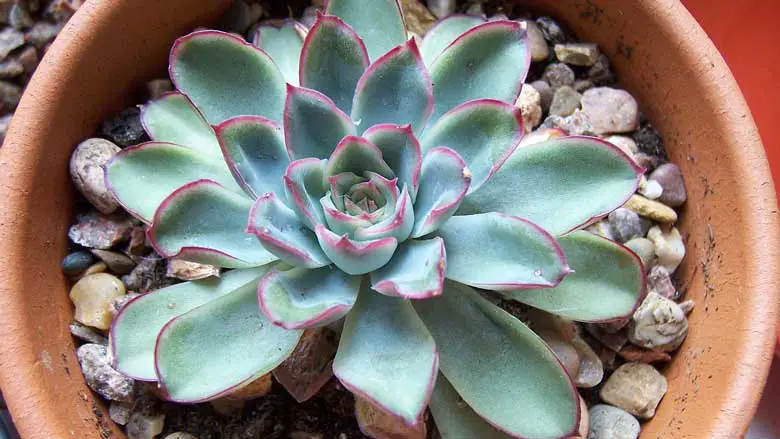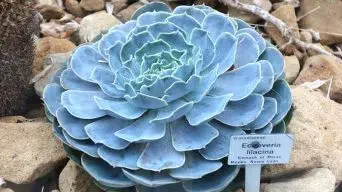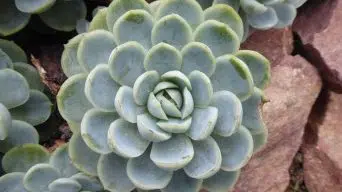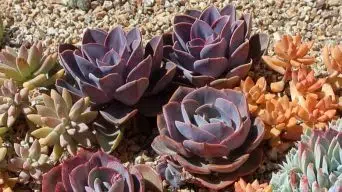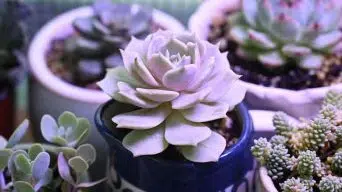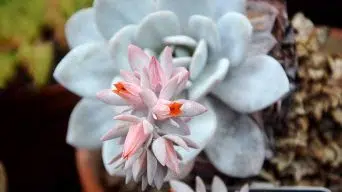Growing Echeveria succulents is an enjoyable and rewarding hobby, as they’re stunningly beautiful and highly adaptable indoor plants.
One uncommon Echeveria species is the Echeveria Pelusida. This rosette shape plant has a delicate look, which makes it one of the favorites among succulent lovers.
This article provides you with all the tips and information you need on Echeveria pelusida succulents, including how to grow them, their specific needs, and how to propagate your Echeveria pelusida plant.
Overview
Echeveria pelusida is a beautiful small variety of the Echeveria genus from the Crassulaceae family.
The small rosettes, which grow about 6 to 8 inches tall, are made of blue-green leaves with red margins and tips, which become more apparent when exposed to bright light.
The Echeveria pelusida produces brilliant yellow flowers in the spring.
How To Care for Echeveria Pelusida
Echeveria pelusida care is easy if you know what it needs to grow and survive.
Many people don’t know how to take care of them, so they end up killing them.
This comprehensive guide will tell you everything about echeveria pelusida care that will help you keep your plant alive and thriving.
Sun Exposure & Light Requirements
Echeveria pelusida mostly requires full sun exposure to thrive, but it can also tolerate partial shade.
They need to be placed in direct sunlight for at least 4 hours per day.
Echeveria pelusida plants prefer bright light, which stimulates proper plant growth and flowering. Be careful not to leave them exposed to direct sunlight for too long during the hottest parts of the day.
When grown indoors, place your succulents near a west or east-facing window, as these orientations offer some afternoon shade.
If you notice that your plant is not putting on new growth or flowering, try giving it more sunlight to see whether this helps encourage it to sprout new leaves and flowers.
Watering Requirements
Echeveria pelusida is easy to grow if you can remember a few simple rules.
It should only be watered when the soil is completely dry and should never be allowed to sit in water.
Additionally, the plant should be watered with a very fine spray to ensure that the leaves don’t get wet, leading to fungal or bacterial growth.
It is also essential to allow the water to drain through the holes in the bottom of the pot to prevent root rot.
Echeveria pelusida will like to be slightly underwatered than overwatered. It is better to err on the side of caution and allow the soil to dry out before watering again.
Soil Requirements
Like most succulent plants, the Echeveria pelusida plant needs well-draining soil.
This is because succulent plants retain water in their leaves, making them heavy.
The plant will turn to its taproot or main root for nutrients and moisture when this happens.
The Echeveria pelusida plant’s taproot can eventually rot if the soil doesn’t drain well enough.
The best soils to use are a cactus potting mix, succulent soil, or a combination of both.
These types of soils are light and allow the roots to breathe better than heavy soils.
If these types of soils aren’t available, you can make your own soil mixture by mixing one part coarse sand, two parts potting mix, and one part perlite.
Temperature and Humidity
Echeveria pelusida is a desert plant that originally grows in rocky areas where almost no other plants can survive.
Therefore, it can be a little finicky when it comes to the environment, especially with respect to temperature and humidity.
Therefore, it should ideally be kept between 68° to 80° Fahrenheit (20 to 27°C) and should be kept away from air conditioners and radiators.
The plant requires low humidity, with a minimum of 40% and a maximum of 60%. The plant will be best in a room that is not humid.
If the humidity is too high, then it may lead to root rot or other related diseases. This makes it an ideal houseplant for someone that lives in a dry climate.
Fertilizing
Pelusida Echeveria does not require much fertilizing.
Maybe feed every month with a balanced liquid fertilizer diluted to half-strength during the growing season.
Echeveria succulents are very sensitive to overfertilizing. It can cause them to blacken and look burned at the tips.
If that happens, stop fertilizing and turn the plant into the shade for a while.
Potting and Repotting
It is unnecessary to repot Echeveria pelusida often, but if you plan to keep this succulent for a while, it may be required.
The plant should just fit into the pot without much room to spare. Repotting every few years will allow the plant to grow into its container.
When choosing a pot, select one that will allow for drainage and air circulation.
The best containers are terracotta or unglazed pots because these let the soil dry out faster and prevent root rot. If you choose a plastic pot, make sure to provide drainage holes.
Echeveria pelusida does well in its permanent container until it grows too big, then, it is time for repotting.
The best way to do this is to remove the plant from the old pot and remove as much soil from the roots as possible.
Use a knife to trim away rotted, mushy, or discolored sections of the roots.
Repotting in fresh potting soil is best so that no diseases are left in the old soil.
If you plan on letting your Echeveria plant flower, it should be repotted every year or two after it is done flowering.
Pruning
Echeveria pelusida is a small, slow-growing succulent plant up to around 4 inches tall.
Since this plant doesn’t grow too tall, it isn’t likely that you’ll ever need to prune or cut any part of the Echeveria pelusida plant.
Only damaged and dead leaves will need to be removed to prevent the spreading of dangerous diseases.
Also, if you find the Echeveria plant becoming too tall or leggy, cut off a large portion. The parts that have been cut can then be used to propagate a new Echeveria pelusida plant.
Pests and Diseases
If not properly cared for, pests or diseases can affect the Echeveria Pelusida succulent plant.
Pests
Some common pests that might infect your plants are mealybugs, scale insects, aphids, or spider mites.
Mealybugs
Mealybugs are tiny, parasitic bugs that suck juices from plants.
They have a waxy white coating on their bodies, making tending to them quite tricky.
You can tell if you have mealybugs by looking for cotton-like substances on the ends of leaves or yellowish leaves.
To remove mealybugs, wipe them off using a cotton swab dipped in alcohol.
Scale Insects
The Echeveria Pelusida plant may be susceptible to scale insects, which are among the frequently encountered pests on succulents.
They are small, oval-shaped insects with hard shells covering their bodies.
Their presence on your succulents can be identified by looking for bumps on the Echeveria pelusida or yellowing leaves.
They can be removed by wiping the leaves with a damp cloth.
Aphids
Aphids are another common pest that can harm your succulent plant.
These insects leave a sticky residue on plants known as honeydew, which can then attract other pests such as ants and bees.
You can identify whether or not you have aphids by looking for small green insects.
Ants love the honeydew, so if ants come to your plant, this is a sign of a problem with aphids.
To remove the Aphids from your Echeveria Pelusida, spray them with insecticidal soap or rubbing alcohol.
This will help you eliminate these pests, but it may also kill beneficial bugs in your garden.
Spider Mites
Spider mites are a common problem with Echeveria Pelusida plants.
They are tiny, spider-like insects that suck juices from plants. White or yellow spots on the plant leaves or discoloration can identify their presence.
To remove them, try rinsing the leaves with water to loosen their hold, then carefully dry away any excess moisture using a soft cloth.
If you notice spider mites on the underside of the leaf, you can also try putting a drop or two of dish soap directly on them before wiping it away.
Diseases
Echeveria Pelusida succulent plants can also develop different kinds of diseases if they are not taken care of properly.
Some common problems are leaf spots, root rot, and powdery mildew.
Leaf Spots
There may be some dark green or brown spots on the leaves of your succulent plant.
These spots usually have a white growth on them that might look dusty. These spots can quickly spread and infect all of your plant’s leaves if not taken care of.
To help prevent leaf spots from spreading, make sure to remove any fallen leaves in your garden.
Also, try removing the spots by dabbing them with rubbing alcohol or a cotton swab dipped in rubbing alcohol.
Root Rot
Root rot is an issue for succulents that are overwatered.
Your plant’s roots will turn black, mushy, and smell bad. This problem can be prevented by only watering the Echeveria Pelusida when the soil is dry.
Powdery Mildew
This problem occurs when there is a lack of air circulation.
Powdery mildew makes the leaves appear white and can also attract pests such as mites to your plant.
When watering your succulent plant, ensure good air circulation so that your Echeveria Pelusida will not develop problems from being overwatered or from a lack of air circulation.
How to Care for Echeveria Pelusida in Winter
The growing period for Echeveria Pelusida plants generally begins in spring and continues through summer.
However, these plants can also be grown indoors year-round in areas with cooler temperatures (i.e., 50° F or below).
As the weather turns colder outside, it is best to protect your plant by moving it indoors.
The windows of your home are often good places to grow plants during winter, but it is also possible to use grow lights indoors instead of natural sunlight.
Either way, ensure the plant receives enough light for 6 hours every day during the winter months.
To keep your Echeveria Pelusida thriving, make sure it stays in a room with temperatures between 65° and 80° F (18° and 27° C).
Also, reduce watering at this time of year and only water your plant when the soil is completely dry.
How To Propagate Echeveria Pelusida
Echeveria propagation is usually straightforward. One of the easiest succulents to propagate, the Echeveria pelusida, can be propagated by leaf cuttings or stem cuttings.
Leaf Cutting Propagation
Echeveria propagation by leaf cuttings is one of the easiest ways to propagate Echeveria pelusida.
To propagate Echeveria pelusida by leaf cuttings:
- Select a healthy leaf from an actively growing Pelusida.
- Cut the leaf at or near the base of the leaf stem using a sharp, sterile blade (such as a scalpel or hobby knife).
- Let the leaf callus over for 2 to 3 days.
- Plant the leaf-cutting in a container filled with a well-draining succulent soil mixture.
- Place the container in indirect sunlight and water thoroughly when the soil is dry.
- Roots will begin to appear in 2 to 3 weeks.
- Plant the rooted leaf cutting into a larger container or in the garden when the root system is established.
And there you have it! A healthy, leafy Pelusida plant.
Stem Cutting Propagation
Echeveria Pelusida is a succulent plant that can easily be multiplied by cutting off and replanting its stems.
To propagate Echeveria pelusida by stem cutting:
- Cut off a stem part, cutting at any point on the stem where it is not growing.
- Let the cut end dry out for some days until it forms a callus over the cut surface. This is to prevent rotting.
- When the callus has formed, put the stem end in some slightly moist cacti- or succulent potting mix so that only the dried-out cut part above the soil emerges from it.
- Put your cutting where there is a lot of indirect light and water your cutting sparingly.
- In a few weeks, new shoots will grow from the soil.
- Plant your new Echeveria Pelusida plant wherever you want.
Echeveria pelusida propagation can be easily achieved through leaf cuttings or stem cuttings.
Be sure to use a sterilized blade for Echeveria propagation by cutting.
Final Thoughts
Growing succulents can be a fun, low-maintenance hobby.
In addition to being attractive and making your house look great, succulents can provide you with a sense of comfort and serenity while lowering stress levels in the home.
Echeveria Pelusida care and propagation can be easy and fun if you understand that these plants like very bright but indirect sunlight, well-draining soil, and occasional water.
Providing the right conditions and proper care for Echeveria pelusida will result in a plant that thrives and provides years of interest.
Try not to get discouraged if your plants seem to suffer at first, they are very resilient once you get the hang of their watering habits.

